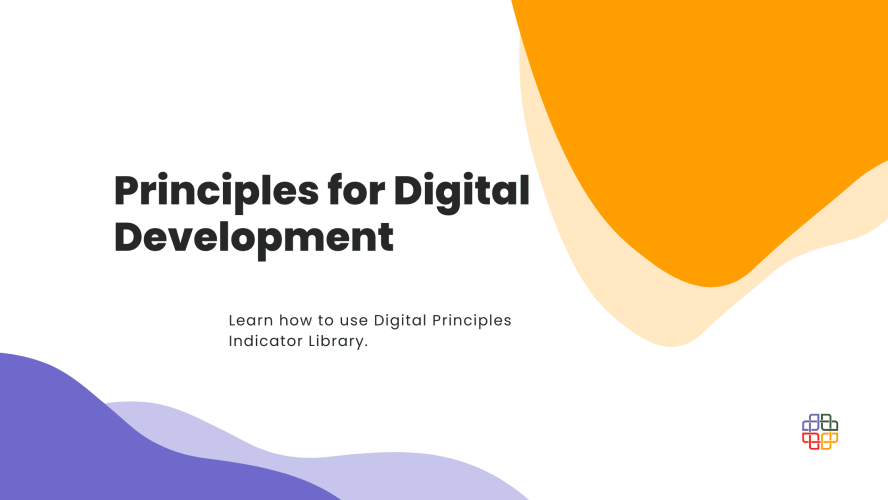The Principles for Digital Development community is constantly growing and evolving. On this journey of improvement, a need for new resources appeared. After a period of promoting and spreading awareness about the Digital Principles, there came a time for measuring practical and intentional use of the Principles.
As we mentioned in our previous articles, the Digital Principles team answered the emerging needs of the community and created three Evaluation Tools:
- Digital Principles Organizational Self-Assessment;
- Digital Principles Indicator Library;
- Digital Principles-Focused Evaluation.
Each of these serves different purposes and is useful in different phases of self-evaluation. We’ve already covered the topic of the Digital Principles Organizational Self-Assessment Survey, as well as we summarized the best practices of gold-level endorsers.
This time, we will shed some light on the Digital Principles Indicator Library, it’s structure, its purpose and also the philosophical background behind this tool.
The Library of Choices
First of all, let’s crack the name of this tool. It consists of two quite enigmatic words: indicator and library. The Digital Principles team provides a guide to this tool, where they describe their understanding of the word indicator:
“Indicators or metrics are the manifestations, observations, or empirical evidence of the object of measurement, often abstract concepts, which in this case are the specific Digital Principles in practice. When indicators of performance are observed and reported without comparison to standards or criteria, indicators are used for descriptive measurement. When indicators of performance are compared with criteria and standards, indicators are used for evaluation.”
Based on this definition, indicators can mean different things and take on different roles. It depends on the context in which we place them and the way in which we use them. The purpose of indicators in the context of this particular tool is described as the following:
“These process indicators that focus on activities and outputs are intended to measure how and how well the Digital Principles are being put into practice in principles-driven digital development initiatives.”
In other words, the Digital Principles team created a list of potential actions that endorsers could take, and then converted these actions into indicators. Their purpose is to measure how well the recommended action is performed.
The second word, library, is much more straightforward. In this context, a library can mean a database, a catalogue or a bank of indicators. It’s accessible for everyone and there are plans for further updates of its content.
In conclusion, the Digital Principles Indicator Library is a bank of possible activities and outputs that are ought to help endorsers in the process of practical implementation of the Digital Principles.
However, the authors of the guide stress one important thing – the significance of choice. Specific indicators will properly serve their purpose only in specific circumstances. It’s important to choose them wisely, with consideration of the type of a project we’re working on, and a quality framework that we plan on using.
The Structure of Digital Principles Indicator Library
The Indicator Library currently consists of almost 300 positions, filed by the Principle they correspond to. It is presented in the form of an Excel spreadsheet that can be accessed and downloaded by anyone who is interested, here.
The indicators are selected into two types: activities and outputs. Measuring input and outcome is not included in this tool’s functionalities. The reason for it being the fact that other tools, such as the Organizational Self-Assessment Survey, are serving the purpose of detecting the level of overall engagement with the Principles, whereas the Indicator Library is dedicated to listing actions specific to each of the Principles.
Each indicator is assisted by additional information, such as: description, theme, common methodology (for some), type (activities and outputs mentioned above), reporting format, project lifecycle stage, resources and user notes (for some).
Example
To give you a quick idea of how this tool actually looks like, here is an example:
This indicator represents the Reuse and Improve principle. Its purpose is to indicate whether there are plans on monitoring the usage of added features. Implementing such a plan will count as a contribution to the Reuse and Improve principle because it will help in enhancing the already existing features. In the table below you can find further information about this specific indicator, its format and the stage on which it is of service.
The Importance of Intended Use
Digital Principles Indicator Library certainly is a useful tool that can help to grasp a better understanding on what the actual use of the Principles in practice looks like, and how we can measure it. The tool itself was created with the guidance of the Principles: Understand the Existing Ecosystem and Reuse and Improve.
However, with great value comes a risk. In the guide to the Indicator Library, the Digital Principles team voice their concerns. They point out that principles are the means of achieving goals, and not the goals themselves. Sometimes it can be difficult to distinguish these two things. It is also an important challenge to use the Principles intentionally, but at the same time do not misuse them, by turning them into projects.
For further guidance, we recommend the last one of Evaluation Tools: Digital Principles-Focused Evaluation. We’ll be posting on this topic soon!
Sources
Digital Principles Indicator Library
Digital Principles Monitoring, Evaluation, & Learning Part 2: The Indicator Library




